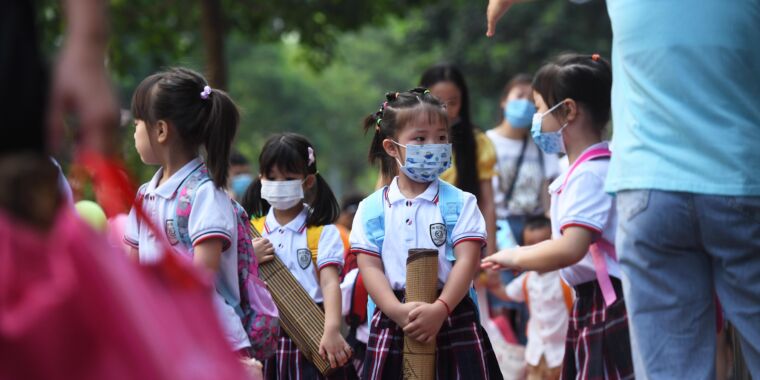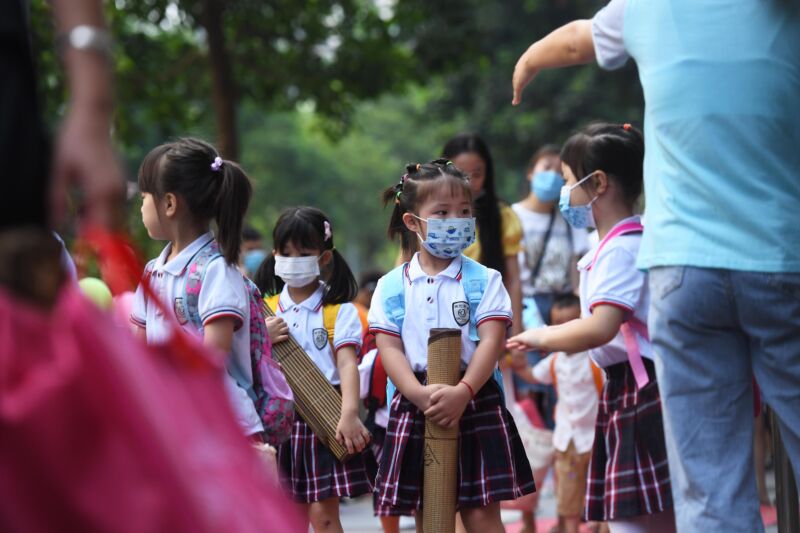

Enlarge/ Kids return to kindergarten following COVID-19 lockdown.
In our soft COVID bubbles, our body immune systems might be getting soft.
Physical distancing, lockdowns, masking, and spirited sterilizing all mean we are entering contact with less garden-variety germs than normal. This year’s influenza season was essentially cancelled.
While that may seem like a welcome reprieve from seasonal ailments and pesky sniffles, specialists fear that our immune systems might be losing their protective edge in the lull. And with the typical tiny suspects lying in wait for our return to some sense of normalcy, it might indicate that nasty bursts of common colds and flu-like illnesses are in our post-COVID futures– ones that might not be avoidable even if we carry on with some of our COVID safety measures.
That seems to be what played out in Hong Kong. In an analysis released in the journal Emerging Contagious Illness, researchers kept in mind a significant burst of upper respiratory infections there shortly after kids went back to schools and day cares in October2020 The break outs appeared despite the fact that teachers and trainees were still following stringent COVID safety measures.
” Staff and students wore face masks at all times; lunch hours were cancelled, desks were spaced out, and group activities were limited,” the researchers kept in mind.
Still, by the end of November, the scientists tallied 482 break outs of upper respiratory infections in schools. Of the break outs, 308 remained in primary schools and 149 remained in kindergartens, child care centers, and nursery schools. The remaining 25 remained in secondary schools. With the widespread outbreaks, officials began requiring territory-wide school closures in mid-to-late November.
When researchers looked at lab screening on the specific germs behind the snotty surge, they found no infections from the unique coronavirus, SARS-CoV-2, and no infections with influenza infections. Instead, the testing pointed to rhinoviruses and enteroviruses– culprits of the common cold and other similarly mild infections.
Roaring back
The scientists hypothesize that the burst of irritating bugs was substantiated of immune reactions in the kids waning while in-person knowing was mostly shut down in between January and late September. A cross-sectional survey had earlier suggested that 75 percent of school kids did not have contact with individuals outside their households while they were out of school.
As cases of colds and flu-like diseases dropped during that time, “population vulnerability to rhinoviruses and other breathing viruses, including influenza infections, might have been increasing over time since individuals were likely less exposed to the viruses when extreme social distancing procedures, consisting of school dismissals, were carried out in action to the COVID-19 pandemic,” the researchers recommend. “This would have increased transmission capacity when schools resumed.”
They note that a comparable rise in common colds was seen in grownups in England a few weeks after schools resumed there in September.
” Nonpharmaceutical interventions may differ”
As for how the infections still managed to spread with the COVID-19 precautions in place in the resumed schools, the researchers have another hypothesis: basically, COVID preventative measures do not work well versus typical cold germs. Face masks have actually been revealed to effectively obstruct coronaviruses and influenza viruses– however they’re less effective at blocking rhinoviruses And rhinoviruses are hardier than coronaviruses and influenza viruses when it comes to enduring disinfectants.
Normally, different breathing infections utilize the same set of transmission modes (surface areas, breathing beads, etc.), but “how much each mode adds to transmission of a specific virus remains unclear; for that reason, the effectiveness of particular nonpharmaceutical interventions may differ between viruses,” the researchers write. In other words, masks and disinfection may be extremely effective against flu viruses and SARS-CoV-2, however they might not be as efficient against your basic snotty-kid bacteria.
” Our findings highlight the increased risk positioned by typical cold infections in areas where schools have been closed or dismissed for extended periods throughout the COVID-19 pandemic,” the researchers conclude.
No comments:
Post a Comment